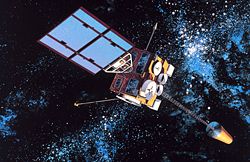 Artist's impression of a GOES-D series satellite | |
| Mission type | Weather satellite |
|---|---|
| Operator | NOAA / NASA (1987-1999) Peacesat (1999-2012) |
| COSPAR ID | 1987-022A |
| SATCAT no. | 17561 |
| Mission duration | 3-7 years (planned) 25 years (achieved) |
| Spacecraft properties | |
| Bus | HS-371 |
| Manufacturer | Hughes |
| Start of mission | |
| Launch date | 26 February 1987, 23:05 UTC |
| Rocket | Delta 3914 |
| Launch site | Cape Canaveral LC-17A |
| Contractor | McDonnell Douglas |
| End of mission | |
| Disposal | Decommissioned |
| Deactivated | 12 April 2012 |
| Orbital parameters | |
| Reference system | Geocentric |
| Regime | Geostationary |
| Longitude | 75° West (1987-1989) 98° West (1989-1992) 112° West (1992-1995) 135° West (1995-1999) 95° West (1999) 175° West (1999-2012) |
| Slot | GOES-EAST (1987-1989) GOES-WEST (1995-1999) |
| Eccentricity | 0.0002306 |
| Perigee altitude | 35,879 kilometres (22,294 mi) |
| Apogee altitude | 35,898 kilometres (22,306 mi) |
| Inclination | 15.09° |
| Period | 24 hours |
GOES-7, known as GOES-H before becoming operational, is an American satellite. It was originally built as a weather satellite, and formed part of the US National Oceanic and Atmospheric Administration's Geostationary Operational Environmental Satellite system. Originally built as a ground spare, [1] GOES-H was launched in 1987 due to delays with the next series of satellites. It was operated by NOAA until 1999, before being leased to Peacesat, who use it as a communications satellite. [2] As of 2009, it was operational over the Pacific Ocean, providing communications for the Pacific Islands. On April 12, 2012, the spacecraft was finally decommissioned and moved to a graveyard orbit. [3]

